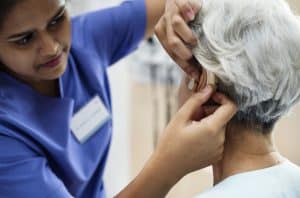There are many hearing aid manufacturers creating hearing aids in a wide variety of types and styles. Picking which device is best for you can be an overwhelming decision. Your audiologist is here to help. The process of selecting the right device is known as a hearing aid fitting.
Testing Your Hearing
The first step in the hearing aid selection process is to determine your exact type and degree of hearing loss. This is important, as not every hearing aid style is appropriate for all degrees of loss.
Following a physical exam and a review of your medical history, your audiologist will complete a comprehensive audiology evaluation. You may be given any or all of the following tests:
- Pure tone testing
- Bone conduction testing
- Speech testing
- Acoustic reflex testing
- Auditory brainstem response
- Otoacoustic emissions
Discussing Your Needs
Adult hearing aids are complex electronic devices designed to help you hear in a variety of listening environments. Discussing how you spend most of your time can help your audiologist determine the level of amplification you will require.
Those who work in a busy office, frequently attend concerts at Katy Vibes or often find themselves in large group settings will require the highest level of available technology. More technology may mean a higher price tag, which may not be worth it for someone who spends most of their time with a small group or in a quieter setting.
The more advanced your hearing aid, the better the device is at switching between different listening situations with varying degrees of background noise.
Determining a Style
Unlike the big, bulky hearing aids you remember your parents or grandparents wearing, new hearing aids are sleek and modern. They are available in a number of styles, from models that sit behind the ear to those that are practically invisible.
Your audiologist will do what they can to recommend a hearing aid that is in line with your aesthetic preference. But keep in mind that not every style works with all degrees of hearing loss.
To learn more about what goes into a hearing aid fitting or to schedule an appointment with a hearing aid expert, contact Today’s Hearing.
